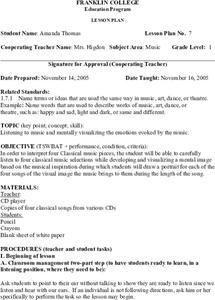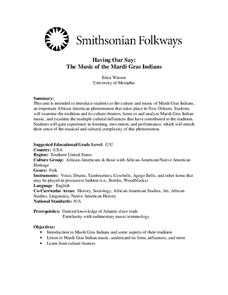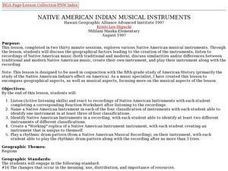Curated OER
Sing a Song of Science
Using parodies of popular music to introduce and reinforce concepts in secondary classrooms.
Curated OER
Music and Emotions
First graders examine how certain types of music can evoke emotions and mental images. They fold a piece of paper into four equal sections, and create a picture of what they are visualizing in each section while listening to four...
Curated OER
Musical Genre Pie Charts
In this pie chart worksheet, students transpose musical genre data to the charts and then answer questions about the results.
Curated OER
Who Wants To Be A Mini Maestro?
Students are introduced to classical music. They listen to Beethoven's Fifth Symphony. They interview each other in regards to their feelings about the music and the paintings they produced while listening to the piece.
Curated OER
Counterpoint Activities: Listening and Discussion
Students assess whether or not a piece of music is contrapuntal. In this music education lesson, students listen to various pieces of music and identify whether the music is contrapuntal or not contrapuntal.
Curated OER
Musical Moods
To celebrate diversity and the purpose of Harmony Day, the class examines culturally diverse music and expression through line drawing. They discuss that all cultures produce music and that music can convey mood just like art can. As the...
Smithsonian Institution
The Music of the Mardi Gras Indians
The traditions, costumes, and the music of the Mardi Gras Indians, African-Americans and those with African American or Native American Heritage are the focus of a unit that introduces class members to a little-known group that plays a...
Curated OER
The Affect of Music on Visual Images
Eighth graders consider cross-curricular connections between social studies, singing, and current events. They listen to the song, "I Can't Cry Hard Enough." view scenes from September 11, then create presentations using images, a...
San Francisco Symphony
Music and Early Man
Creative projects are great ways to increase interest in topical research. Middle schoolers learning about primitive life styles in the Americas explore the importance of music to hunter gatherers. They research and create musical...
San Francisco Symphony
Prehistoric Music
What was music like during the Stone Age? Learners listen to a CD entitled, Art of Primitive Sound as they consider the culture of people in the Stone Age. They use objects found in nature to create instruments, and then perform a...
Curated OER
Musical Form of "The Star-Spangled Banner"
Students use a recording of "The Star Spangled Banner," to identify the AABC form of the anthem and describe the repetitions and contrasts in the piece of music. They memorize the music in eight-measure phrases being aware of the form...
VH1
Lessons for Hight School Music Classes: Lesson 2
Art and music have been vehicles for statements of civil unrest for hundreds of years. Upper graders critically analyze several pop songs or music movements from the 1980s that exemplify politically charged motives. They analyze lyrics...
K12 Reader
The Pitch and Volume of Sound
Primary graders are introduced to the concepts of pitch and volume with a reading comprehension learning exercise that focuses on the physics of sound.
San Francisco Symphony
Music Reflects History
Exploring the baroque era can be exciting and fun when it's done thorugh the arts. Middle schoolers examine the music and art history of the baroque era through research. They use their findings and class notes to create an expository...
National Park Service
Lesson 1: Journaling with Songs of Freedom
There's more to music than a memorable tune. The songs of those who were enslaved reveal the harsh realities of their lives. Using both songs and slave narratives, historians uncover this hidden history. The lesson incorporates a variety...
Curated OER
Upward and Downward Motion of Melody
First graders explore the notion of upward and downward melody motion. They hum, sing, and listen as the melody moves up and down. To show what they know, they put their thumbs up or down as the melody shifts.
Curated OER
Musical Imagery
Learners experience musical imagery. They link this musical concept to literary imagery to gain an understanding of the use of imagery in both genres. After listening to a varriety of sounds, students will compose and perform a melody.
Curated OER
Haunting Music
Students discover music that was inspired by the spooky and bizarre. In this music of Hector Berlioz and Camille Saint-Saens activity, students identify elements of music and listen to the Symphonie Fantastique and Danse Macabre....
Curated OER
Moog's Musical Revolution
Students explore history of technological advances in making, recording, and listening to music that have intrigued and inspired musicians and scientists for decades.
Curated OER
SIGHT READING RHYTHM PATTERNS
The perception of rhythms by reading and the ability to auditorily discriminate these rhythm patterns by listening to them performed by the teacher is practiced here. your students will work to create an eight-beat long rhythm pattern.
Curated OER
Explore Literary Devices in Popular Lyrics
Bring literary devices to life by listening to popular song clips and studying their lyrics.
Curated OER
Native American Indian Musical Instruments
Young scholars listen and react to recordings of Native American Instruments with each student completing a corresponding Reaction Worksheet after listening to the recordings.
Curated OER
Slang Quiz: Music
For this slang quiz worksheet, students analyze the music slang examples in the sentences and select the best meaning to complete 10 exercises.
Berklee College of Music
Create Your Own Afro-Latin Groove
The backbone of Latin American music is the beat! Young musicians work on blending Afro-Latin rhythms and beat patterns before incorporating the major pentatonic, minor pentatonic, and blues scales in their own compositions.

























